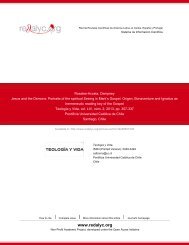A Key Concept in Modern Translation Theory - Redalyc
A Key Concept in Modern Translation Theory - Redalyc
A Key Concept in Modern Translation Theory - Redalyc
Create successful ePaper yourself
Turn your PDF publications into a flip-book with our unique Google optimized e-Paper software.
64 EQUIVALENCE REVISITED: A KEY CONCEPT IN MODERN TRANSLATION THEORY<br />
However there is still much controversy as regards the nature of this notion<br />
known as equivalence, to the extent that some authors even discard it as an<br />
unnecessary concept <strong>in</strong> translation theory. R. Rabadán (1991) summarizes<br />
adequately this bipolar situation:<br />
“Como vemos, lejos de estar cerrado, el debate entre defensores y detractores de la<br />
equivalencia, se recrudece con cada nueva publicación (cf. Pedersen, 1988:11-29; Snell-<br />
Hornby 1988:13-21; Albrecht, 1990). Esta noción compleja e <strong>in</strong>determ<strong>in</strong>ada parece estar condenada<br />
a seguir siendo la cuestión clave, y s<strong>in</strong> duda la más polémica, de los estudios contemporáneos<br />
de traducción. La raíz del problema está en que la equivalencia constituye la<br />
esencia misma de la traducción, y de ahí el gran reto con que nos enfrentamos: cómo conseguir<br />
que el texto orig<strong>in</strong>al y su traducción sean ‘el mismo texto’ cuando todos los factores que<br />
<strong>in</strong>tervienen en el proceso son, por def<strong>in</strong>ición, dist<strong>in</strong>tos (cf. Ste<strong>in</strong>er, 1975:261)”. (p.31)<br />
In the rema<strong>in</strong><strong>in</strong>g part of this paper two antagonistic positions <strong>in</strong> translation<br />
theory for and aga<strong>in</strong>st equivalence as well as the criticism aga<strong>in</strong>st L<strong>in</strong>guistics/<br />
Text-oriented Theories (TOT) will be analyzed. Then arguments for and aga<strong>in</strong>st<br />
the notion of equivalence with<strong>in</strong> TOT and COT (Non-L<strong>in</strong>guistics/Context-oriented<br />
Theories) will be discussed <strong>in</strong> detail and new perspectives will be reviewed.<br />
F<strong>in</strong>ally, equivalence with<strong>in</strong> the framework of a Dynamic <strong>Translation</strong> Model (DTM)<br />
will be discussed and some brief illustration of its application <strong>in</strong> translation criticism<br />
will be provided.<br />
2. LINGUISTICS/TEXT-ORIENTED VERSUS NON-LINGUISTICS/<br />
CONTEXT-ORIENTED TRANSLATION THEORIES<br />
Despite the huge amount of bibliography that is be<strong>in</strong>g published <strong>in</strong>creas<strong>in</strong>gly<br />
almost everywhere about translation theories, L. Venuti (1998) dist<strong>in</strong>guishes two<br />
opposite approaches <strong>in</strong> relation to translation: l<strong>in</strong>guistic and aesthetic.<br />
“The prevalent approaches can be divided -loosely but without too much<br />
conceptual violence- <strong>in</strong>to a l<strong>in</strong>guistics-based orientation, aim<strong>in</strong>g to construct an<br />
empirical science, and an aesthetics-based orientation that emphasizes the cultural<br />
and political values <strong>in</strong> form<strong>in</strong>g translation practice and research.” (p.8)<br />
We propose to dist<strong>in</strong>guish these two approaches <strong>in</strong> translation studies as<br />
follows:<br />
- Non-L<strong>in</strong>guistics/Context-oriented Theories (COT)<br />
- L<strong>in</strong>guistics/Text-oriented Theories (TOT)
















